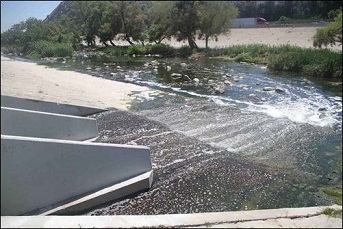Agreement reached on process for evaluating environmental flow needs of L.A. River

A diverse coalition of water-quality managers has reached agreement on a scientific process for evaluating whether flows in the Los Angeles River can be reduced for water-recycling purposes while simultaneously protecting the ecological and recreational benefits provided by the river’s flows.
The agreed-upon process for evaluating environmental flow requirements – described in a SCCWRP technical report published in early May – represents the culmination of three years of research and extensive deliberations about how to use science to inform managers’ options for balancing competing demands on the L.A. River’s limited flows.
The study, which was co-led by SCCWRP, is expected to serve as a precedent-setting template that paves the way for managers to set environmental flow decisions statewide.
More than 50 stakeholders endorsed the technical approach for evaluating environmental flow targets, including wastewater agencies that discharge treated effluent into the river, stormwater management agencies that manage wet and dry weather runoff into the river, water-quality regulatory agencies and other stakeholders.
Water-quality managers for the L.A. River and similar effluent-dominated streams plan to immediately use the new approach to evaluate if and/or how much flows can be diverted while still protecting ecological and recreational benefits.
Already, two wastewater agencies that discharge treated effluent into the L.A. River have applied for regulatory approval, under State Water Code Section 1211, to begin recycling more of their effluent. More agencies are expected to seek this regulatory approval in the coming years as more water gets recycled across drought-prone Southern California.
The agreed-upon approach for evaluating environmental flow targets consists of a scientifically defensible toolkit that enables managers to systematically consider the ecological flow needs of multiple sensitive species and habitats along an urban, 45-mile stretch of the L.A. River. The approach also considers the multiple recreational benefits provided by the river’s flows, including fishing and kayaking.
Historically, these types of environmental flow analyses have been limited in scope, consisting of just a few endpoints, such as protecting a single species or a single beneficial use.
The L.A. River approach also is aligned with the California Environmental Flows Framework, a standardized, multi-step process that guides managers in developing environmental flow targets for streams statewide. The L.A. River approach is designed specifically to help managers develop scientifically sound flow targets for Southern California’s effluent-dominated streams.
The tools built to support the L.A. River’s flow evaluation approach already have been adapted and used for other projects, including an ongoing effort to restore more natural flow patterns to streams in southern Orange County and a study examining how future expected changes in stream flow patterns across the San Diego region will impact sensitive aquatic species and habitats.
For more information, contact Dr. Eric Stein.
More news related to: Ecohydrology, Top News